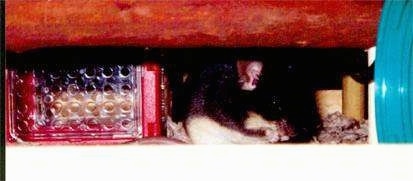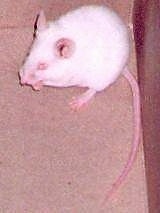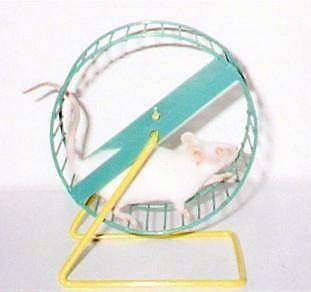"These are my three out of eleven adorable mice. They’re males and their names are Cocoa, Ceaser and Casey. In this picture they’re only about seven months old. I have had them since they were born; they have two more brothers and two sisters. They’re all Siamese except for one sister and one brother who are black. They’re always bouncing and running in their cages and it’s hard to get them to be still, especially when its bath time! Yes, I give all my mice baths; they’re very spoiled and happy."
A small warm-blooded mammal in the rodent family. Most mice kept as pets are domestic pet mice, however, there are many varieties of mice, including longhaired, curly-haired and satin. There is even a fancy variety, which is a rare show mouse and spiny mice, which are desert creatures and a bit harder to care for.
Mice are intelligent, happy, friendly, playful little animals which can make an inexpensive good little pet that is fun to watch. Mice are nocturnal and very social. They will be very active in the evening and night, but not so active during the day. Like all other pets, mice have different personalities. Some will like to be held and played with, some will not. Some will like to run on an exercise wheel while others will not. Some will be shy and just enjoy building a comfortable nest to live and not wish to be played with much at all. Well socialized mice rarely ever bite and are more likely to enjoy being played with. The only time a mouse will bite is to protect itself or its babies from a predator. This is why it is important to handle your mouse regularly to show it you are not a threat. Hand feeding a mouse is an excellent way to socialize it. Be sure to wash your hands before you handle your mouse, as mice are sensitive to smells. Avoid picking up a mouse by the base of the tail. A tame mouse will crawl right into your hand. Put your hand in and allow the mouse to come to you. Let the mouse get used to your hand, then gently scoop it up in your palm, supporting its belly. Sudden movements may scare the mouse into running away or even biting. If the mouse is not tame enough to crawl into your hand, you should hold it gently but firmly at the base of the tail close to its body and lift in to your hand. If your mouse is a nervous one you may have to hold onto its tail to avoid it from leaping out of your hands. You should always have at least two mice. By nature mice are sociable animals and if left to live by themselves they may become withdrawn, lonely and sad. Two females are best, although larger groups are fine if you provide the cage space (ask your vet about spaying and neutering). Male mice can get aggressive toward the other mice in the colony and may have to be separated. Pairs of males should be avoided, unless they are littermates, never separated, and given a large enough cage that they can have their own space. Mice that are not familiar with each other are likely to fight resulting in injury and even death. Mice are timid by nature and need time to warm up to new people. These intelligent little rodents get bored easily and need some kind of entertainment. Providing them with a running wheel, mouse toys (which can be found in pet stores) and things to chew such as toilet paper and paper towel roles will keep them occupied. Building a multi-level home is great for mice as they can then establish their own little colony. Mice have poor eyesight, relying more on their hearing and their excellent senses of smell, taste and touch. They are considered essentially colorblind.
Mice are small, about 3 inches long not including the tail.
The adult mouse weighs about 2/5 to 4/5 of an ounce.
Mice can be kept in hardwood, metal, wire cages or fish aquariums. A fish aquarium with a wire mesh lid to prevent the mice from escaping is the clean choice, however a wire cage allows for better ventilation. Keep in mind that mice like to dig and if kept in a wire cage the mouse may get its bedding all over the floor, so if you are going to use a wire cage you should look for one with a bottom that has high sides. The cage should be at least 25 inches (65 cm) long, 12 inches (30 cm) high and 10 inches (25 cm) wide. Their home should be large enough for them to run and play. Some type of bedding must be provided for the mouse. Bedding keeps the mouse warm and helps to absorb their waste. Watching a mouse build his little home can be quite entertaining. Paper towels, toilet paper, shredded unprinted whitepaper, wood shavings and aspen chips or shavings are some of the best choices. Sawdust, cedar or pine shavings should not be used. Paper towel and toilet paper rolls can be put in the cage, giving the mouse something to chew on. A small hut or house can be purchased at your local pet store providing a nice little sleeping area for your mice to feel safe in.
All bedding should be changed once a week and the cage should be washed and dried. The waste corner should be changed daily to prevent an odor problem. A mouse can drop about 50 fecal droppings per day. Mice are one of the smallest pets in the world but if you do not keep their living area clean, they can come with a big odor. You can get sprays and mice-friendly treatments to help prevent odor problems. Do not put your mouse's cage in direct sunlight or dark corners.
A mouse is a clean little animal. It will groom itself daily, taking care of all of its grooming needs on its own.
Mice can be fed a mixture of rodent foods found at your local pet store, bird seed, unsweetened grain cereals, multi-vitamin pellets and laboratory pellets (lab blocks). Cheese can be fed in small amounts. A wide variety of foods is important to ensure your mice are getting all their vitamins. Fresh vegetables and fruits can be given but should be washed then soaked in water for a half hour to ensure that all traces of pesticides, which can harm your mouse, are washed away. Be sparing with oily seeds, nuts and grain mixes. Food should be put into a ceramic dish; never use a plastic bowl or you will soon be replacing it when the mouse chews it all up. Water must be provided in a gravity driven water bottle which hangs on the side of the cage; dishes should never be used for water.
Mice like to climb and things such as horizontal bars or ladders should be provided to allow them to exercise. If a wheel is given, it should be attached to the side of the cage.
About 1-5 years. Mice living in the wild have a much shorter lifespan.
Mice are generally healthy. If taken care of properly throughout their life they are likely to remain fit and active. Unfortunately mice have poor recovery powers, meaning if they get sick, there is a good chance they will not recover. This is why it is very important to keep their living area clean and feed them a good variety of fresh foods. Do not delay in taking your mouse to the vet if it does not appear well. Sudden temperature changes should be avoided. Mice can get skin mites. If your mouse develops bald spots on its body take it to a vet.
Keeping same sex mice is a good idea, otherwise you may want to get your mice spayed or neutered. Mice can reproduce very quickly. While you can sell the baby mice to pet stores, keep in mind that most mice sold in a pet store are sold as snake feeders. Mice are physically able to reproduce by about 6-8 weeks of age. Their gestation period is about three weeks. They usually have about 8-12 babies in one litter, but can have as few as 1 and as many as 20 babies at a time. Baby mice are born pink and blind and are weaned at about 4 weeks of age. At about 6 days or so the fur will start to grow, and color will appear. If you do not wish to have a bunch of baby mice, un-spayed and un-neutered males and females should be separated at a young age. If your pet store does not separate males and females at a young age you may well end up taking home a pregnant female. In male mice over 6-8 weeks of age the testicles are usually readily visible. One way to tell the sex of a mouse is, under their tails, the distance between the anal opening and genital opening is shorter in the females. It may be hard to tell the sex in young mice. If your mouse gives birth do not disturb the nest and keep the adult males separate from the females. If you must pick up a baby, remove the mother and rub the bedding all over your hands to disguise your scent. Do not handle them too long. After about 10 days the mice will open their eyes, and at this age it is safe enough to handle them. In fact you should handle them in order to make them tame. Mice may breed year-round and a female may have 5 to 10 litters per year.
The mouse is native to central Asia and can be found just about all over the world.
Cocoa, Ceaser and Casey, three male Siamese mice
Cocoa, Ceaser and Casey, three male Siamese mice
Cocoa, Ceaser and Casey, three male Siamese mice
Cocoa, Ceaser and Casey, three male Siamese mice

This is Chief. He's enjoying a banana chip on the couch.

Here's a close-up of Chief on his playground (complete with Habitrail, swing and ladder).

This is an albino mouse named Arctic.

Arctic the albino mouse on an exercise wheel.